Escapes: Beachcombing 101
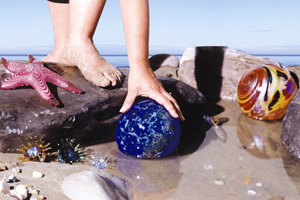
More Japanese flotsam expected along beaches this winter
By Heather Larson
Photo at right: What you might find if you participate in Finders Keepers in Lincoln City, Ore. Photo courtesy of the Lincoln City Visitors and Convention Bureau.
Spending time on a sandy or rocky beach, smelling the salty air and listening to the waves crash in the distance often leads to searching nooks and crannies for treasures. We all like to think of beachcombing as something done on pristine beaches—for shells, crabs, sand dollars, jelly fish, kelp and a variety of other items brought in from the sea.
But there is more to find on Northwest beaches.
Buoyant items like tennis shoes and tree branches drift according to the winds and ocean currents, sometimes for thousands of miles. A great quantity of this type of debris, called flotsam, is expected in the Northwest this fall and winter due to Japan’s tsunami in March of 2011. Nobody can accurately predict what items will come from Japan or exactly when.
Whether good or bad, every piece of flotsam has a tale to tell. It’s up to you to discover that story.
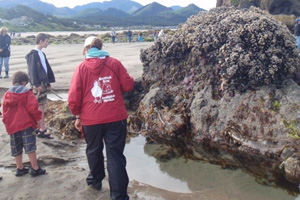
Beachcombing near Cannon Beach on the Oregon Coast. Photo courtesy of Haystack Rock Awareness Program.
“The more time you take to explore, the more you will see,” says Nala Cardillo, program coordinator for the Haystack Rock Awareness Program in Cannon Beach, Ore. “Nature rewards patience.”
Nardillo cautions beachcombers to dress in layers for the unpredictable Northwest weather and to carry rain gear. Footwear should be comfortable and waterproof.
Once you’ve arrived at the beach, what should you do? According to Curtis Ebbesmeyer, Ph.D. and oceanographer, you should walk the high tide lines, which show up as a line of oil or scum with a continuous deposit of fine shell or debris in it. Look even higher past the high tide line for areas rife with logs, but be very careful navigating those logs so they don’t trap you.
Using this methodology, Ebbesmeyer has found animal skulls, bird bones, sand dollars, messages in bottles and much more.
“If you find something, it’s best you don’t disturb it and just take a photo,” says Ebbesmeyer. “Don’t expect to come back the next day and find that treasure in the same spot because it will have disappeared.”
Removing shells, rocks and other works of nature from a beach not only destroys a potential shelter for a homeless sea critter, but it takes away from other people’s beachcombing enjoyment. Today’s camera phones make taking pictures a snap.
Tide Pools
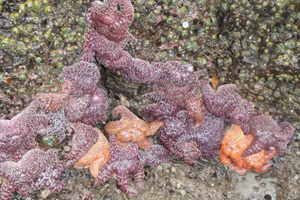
One of the many tide pools at the base of Haystack Rock where you can watch sea life. Photo courtesy of Haystack Rock Awareness Program.
On both the Oregon and Washington coasts, you can find tide pools. They often form around rockier shore lines. Be mindful of where you step so you don’t harm any sea life and stand on bare rock or sand to minimize your impact. Animals live in different zones, so you’ll want to look both in the water and outside the water – foot level, knee level and even higher.
A Sunflower Star (we don’t call them starfish anymore) needs more water, while barnacles and muscles can survive out of water longer.
Think about purchasing a guidebook so you can identify and learn about what you see. Cardillo recommends “The Beachcomber’s Guide to Seashore Life in the Pacific Northwest” by J. Duane Sept.
Do Your Part
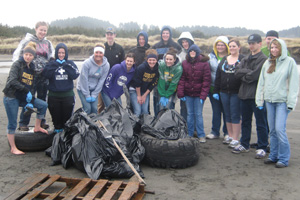
Volunteers for the Grassroots Garbage Gang picking up trash on the Long Beach Peninsula. Photo courtesy of Shelly Pollock.
Packing out trash helps us all enjoy a more beautiful seaside. Ebbesmeyer suggests filling a plastic bag or two of debris every time you beach comb.
To make a real difference, you can join the GrassRoots Garbage Gang (GGG) for their thrice-yearly beach cleanups on Long Beach and Benson Beach in Washington. Shelly Pollock, initiator and organizer of the GGG has found ship ladders, Japanese road markers and a wealth of both good and bad flotsam on coastal beaches.
“The health of our ocean and the uses of our ocean define what is washed up on the shoreline,” says Pollock. “I have a passion to upgrade that health and see our beaches clean and pristine.”
Volunteers are needed for the next GGG beach cleanup in January. You’ll be rewarded with chili and chowder after the cleanup. Email Shelly@ourbeach.org for details.
Finders Keepers
Still another fun way to beach comb is provided by the Lincoln City, Ore. Visitors and Convention Bureau (VCB) in their Finders Keepers Glass Float Promotion.
Beginning in October, they hide glass balls crafted by local artists along the Lincoln City beach. They continue placing these balls, on average of 70 a week, until 2,012 (the same as the year) have been dropped (not hard). The event continues through Memorial Day 2013.
“It’s like a feeding frenzy when we first start,” says Sandy Pfaff, executive director of the VCB. “Finders Keepers is immensely popular and people come from all over to look for these artistic glass balls.”
When you discover one of these balls, you’re asked to report it to the VCB and they will give you information about the artist who made it.
Pfaff assures us that no matter when you visit Lincoln City between mid-October and Memorial Day, there will be glass balls to find. But if you don’t locate one, you can go to the Jennifer Sears art studio in town and blow your own.
It’s always fun to explore beaches with a companion. Bring a friend—you never know what you’ll find.
Optimizing your beachcombing experience
When to Go:
After winter storms (check with www.noaa.gov to make sure it’s safe). Weekdays, start an hour or two before low tide
Where to Go:
Any accessible beach on the Washington or Oregon coast;
Admiralty Inlet between Whidbey Island and the northeastern portion of the Olympic Peninsula in Washington;
At Fort Flagler, eight miles northeast of Hadlock, Wash.;
Surfside, on the Long Beach Peninsula in Washington (no cars allowed). Walk north of Oysterville;
Haystack Rock in Cannon Beach, Ore., for the best tide pools.
Resources:
Finders Keepers Promotion: www.oregoncoast.org/finders-keepers
Jennifer Sears Art Studio: www.jennifersearsglassart.com
GrassRoots Garbage Gang: www.ourbeach.org
NOAA: www.noaa.gov
Haystack Rock Awareness Program: www.ci.cannon-beach.or.us/~Natural/HRAP/hrap-program
Heather Larson writes about travel, nature, and the Pacific Northwest from her Tacoma office. Visit her travel blog at: www.discoverwashingtonstate.com.
If you like this post, you might also enjoy:
Trackbacks For This Post
9 Comments
-
I never visited the Northwest beaches but your article beckons me:-)
-
I love discovering things on the beach – and helping clean them up too. I’m not on the west coast, but these are good tips.
-
I love to read about efforts to clean up beaches. We are on the opposite coast and often pick up stuff as we walk along to deposit in the bin beside the parking lot. With the flotsam from Japan, is no one worried about it being radioactive?
-
Great tips for beachcombing. I love finding treasures on the beach.
-
This is very interesting. As a land locked Midwesterner, these tips helps for those ocean side vacations.
-
This is really fascinating. It totally makes sense that stuff from the other side of the world can travel over, but it’s also a big mind boggling.
-
I’ve visited years ago but never managed to discover one of the glass balls. But it doesn’t matter; it’s such a beautiful area especially for tree huggers like me.
-
I haven’t visited beaches in the Northwest either but reading this makes me want to start planning a trip.

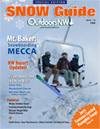
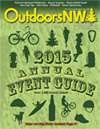
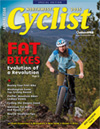
[...] http://goldtravelblog.com/2012/escapes-beachcombing-101/ [...]